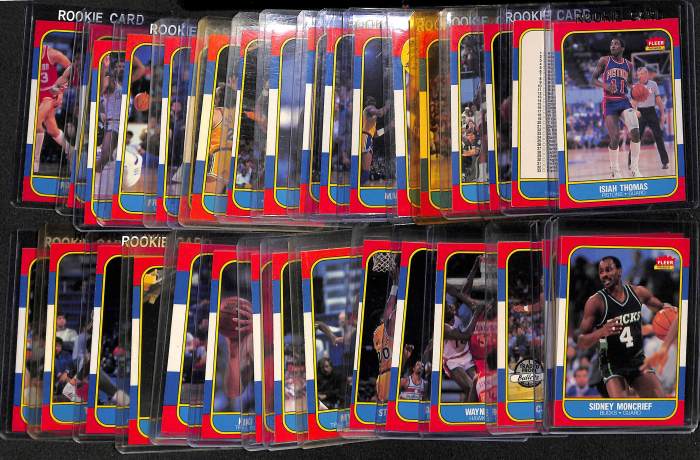The 1986 Fleer Basketball Hobby Box represents a pivotal moment in basketball card history, a time capsule capturing the electrifying era of Michael Jordan’s rookie year and a burgeoning collecting craze. This box, often considered a holy grail for enthusiasts, holds immense value, not just financially, but also culturally, reflecting the nostalgia and excitement of a bygone era. Its current market value is shaped by a complex interplay of factors, from the condition of the cards within to the enduring popularity of the players featured.
Understanding these dynamics is crucial for both seasoned collectors and those newly entering this fascinating market.
This deep dive into the 1986 Fleer Basketball Hobby Box explores its historical significance, investment potential, and the nuances of grading and rarity. We’ll examine key cards, discuss authentication methods, and uncover the cultural impact that continues to resonate with collectors today. From assessing market value to understanding the intricacies of card condition, this guide provides a comprehensive overview for anyone seeking to understand this iconic piece of basketball memorabilia.
Market Value and Historical Significance: 1986 Fleer Basketball Hobby Box

The 1986 Fleer basketball card set holds a coveted position in the hobby, its current market value driven by a confluence of factors including scarcity, condition, and the presence of rookie cards of iconic players. The set’s historical significance stems from its pivotal role in the burgeoning popularity of basketball cards during the mid-1980s, a period marked by a surge in interest in the sport and a corresponding boom in the collectible card market.The release of the 1986 Fleer set coincided with a golden age of NBA talent.
This era witnessed the rise of legendary players who would dominate the league for years to come, transforming the landscape of professional basketball and fueling the demand for their rookie cards. The set’s inherent value is directly linked to the enduring popularity of these players and their sustained impact on the sport.
Factors Influencing Market Value
Several key factors determine the market value of a 1986 Fleer hobby box. The condition of the cards within the box is paramount; pristine, unopened boxes command significantly higher prices than those showing wear or damage. The presence of high-grade rookie cards, particularly those of Michael Jordan, significantly impacts value. Market demand, influenced by factors such as media coverage and overall economic conditions, also plays a crucial role.
Finally, the overall scarcity of unopened boxes contributes to their desirability and value. A well-preserved 1986 Fleer hobby box, especially one containing high-grade Jordan rookie cards, can fetch tens of thousands of dollars in the current market.
Historical Context and Market Impact, 1986 Fleer Basketball Hobby Box
The 1986 Fleer set’s release marked a turning point in the basketball card market. The set featured rookie cards of several future Hall of Famers, including Michael Jordan, who quickly became a global icon. This confluence of factors—the emergence of superstar talent and the growing popularity of basketball—created an unprecedented demand for the cards, driving up prices and establishing 1986 Fleer as a cornerstone set in the hobby.
The set’s success contributed to the broader growth of the sports card market throughout the late 1980s.
Comparison to Contemporary Sets
While other prominent basketball card sets were released in 1986, including Topps and Star, the 1986 Fleer set stands apart due to the superior quality of its photography and the inclusion of key rookie cards. While Topps and Star offered their own sets of rookie cards, Fleer’s crisp photography and overall design aesthetics proved more popular among collectors.
The combination of superior image quality and the presence of Jordan’s rookie card cemented Fleer’s position as the most sought-after set of the year.
Key Players and Their Significance
The 1986 Fleer set included rookie cards of several players who would go on to achieve legendary status in the NBA. Michael Jordan’s rookie card is the most valuable and sought-after card in the set, and arguably one of the most valuable basketball cards ever produced. Other notable rookies included Charles Barkley, and Scottie Pippen. These players, along with others featured in the set, represented a new generation of talent that transformed the NBA into the global phenomenon it is today.
Their presence in the 1986 Fleer set solidified its place in basketball card history.
The 1986 Fleer Basketball Hobby Box transcends mere cardboard; it’s a piece of basketball history, a tangible link to a pivotal era in the sport and the trading card hobby. Its value, both monetary and sentimental, continues to grow, driven by the enduring legacy of the players featured and the nostalgic pull it exerts on collectors. Whether you’re a seasoned investor or a curious newcomer, understanding the factors that influence its value – from card condition and rarity to market trends and authentication – is key to navigating this exciting and potentially lucrative market.
The journey of uncovering and appreciating a 1986 Fleer Hobby Box is as rewarding as the treasures it may hold.

